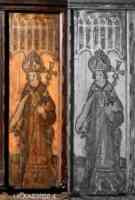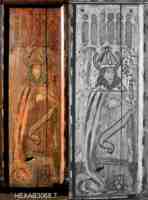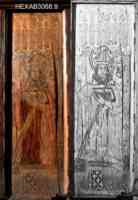HEXAB3068  Hover on Hover on
Thumbnail
to
enlarge |
| North Chancel Aisle Painted Panels |
| painted-panel | flat art |
| wood |
| Ten painted panels each showing a mitred bishop including St Eata, St Wilfrid, and St John of Beverley. |
| This is a section, possibly of rood loft or pulpitum consisting of ten surviving panels. It is a fragment and can be stylistically and technically paired (on the basis of the structure and the pigments) to the Apostle-set now placed at the front of the rostrum [HEXAB203]. The upper transom is original. The panels are no longer set into a sill or bressummer, so they are hanging from a batten or battens behind. Possibly, two or three more panels were part of this scheme originally. |
| late 15th cent |
Some time after 1908, until about 1964: against N wall of N Chancel Aisle, immediately east of the cart hole; see lantern-slide HEXAB9019.18
Prior to 1907: at right-hand (south) end of top row of painted panels on the Smithson Screen facing west.
c.1964: Moved to bottom of partly modern and partly mediæval screen [HEXAB185] in St Etheldreda's Chapel.
1990: “Woodworm prevention treatment carried out in … Bishops' panel screen in St Etheldreda's Chapel, ….” [Churchwardens Record HEXAB9535 p6, 15 Oct]
2012: infra-red photos taken [HEXAB9009]
2022: Discussed and illustrated in article by Lucy Wrapson in Hamilton-Kerr Institute Bulletin no.9 [HEXAB5444]: probably part of a set with the 14 panels of the Pulpit & Screen in the Chancel [HEXAB203].
Feb2023: Conservation cleaning by Hamilton-Kerr Institute's Lucy Wrapson.
09Jul2024: Moved from N side of St Etheldreda's Chapel to E end of N Wall of N Chancel Aisle immediately W of St Wilfrid's Chapel. |
| L 316 cm overall | each panel: H 89 cm | W 25–26 cm except easternmost 21 cm |
| on existing wooden beam |
| Chancel/North Aisle/North Wall/Bay 4 |
1961: “(2) To restore the Mediæval Panel Paintings”; Faculty Regr. no.3. Faculty no. 2195, 10.7.1961
1964. To remove 2 panels of the mediæval paintings on wood from their present position in the North Chancel Aisle to positions as follows: 1. To refix the panel with paintings of the Bishops to the lower part of the screen in St Etheldreda's Chapel. … Faculty reg. no.3. Faculty no.2356, 2.6.1964. NRO EP.184/80. |
HEXAB3068.1  Hover on Hover on
Thumbnail
to
enlarge |
| Bishop 1 Archbishop saint (St Wilfrid or St John of Beverley) |
| painted-panel | flat art |
| wood |
| Has staff, cross and book and partial banner that appears to have been painted out. Background is yellow with red flowers, while behind the now missing tracery it was red. |
| Single board with a number of splits, one section has split off on the right-hand side and has shifted downwards, where it is remounted misaligned. There is a central split starting from the top going halfway and there is a split in the top left-hand side, which runs about 20 cm and which has some movement. There is no framework on the left-hand side of the panel. It is held with a large screw at the bottom of the panel into what appears to be a horizontal batten, which is behind the whole set of panels. Nailed at the top with three nails to some kind of beam or batten behind. Tracery is absent on this panel. |
| late 15th cent |
St Wilfrid is depicted in two other painted panels: HEXAB133.7 & HEXAB202.3, and in windows: HEXAB1406, HEXAB1407.5, HEXAB1417 [misspelt ‘Wilfred’], HEXAB1427, HEXAB1431.3 (twice), & HEXAB1431.4
St John of Beverley is depicted in two other painted panels: HEXAB133.8 & HEXAB202.4, and in windows: HEXAB1417 & HEXAB1431.6 (twice) |
| H 89 cm | W 25 cm |
| Chancel/North Aisle/North Wall/Bay 4 |
HEXAB3068.2  Hover on Hover on
Thumbnail
to
enlarge |
| Bishop 2 St Eata |
| painted-panel | flat art |
| wood |
| Banner, which reads “St Eata VII anos”. Red background with white flowers. Crosier in left hand; right hand raised in blessing. |
| Two splits to the single panel, bottom right hand corner, no movement. Extends approximately 10 cm. Top right hand side stretching through 60% of the panel, no movement. Three nails attach it to batten along the bottom. There are some old nails holding the tracery in place. |
| late 15th cent |
Eata (died 26 October 686), also known as Eata of Lindisfarne, was Bishop of Hexham from 678 until 681, and then Bishop of Lindisfarne from before 681 until 685. He then was translated back to Hexham where he served until his death in 685 or 686. He was the first native of Northumbria to occupy the bishopric of Lindisfarne.
St Eata is depicted in two other panels: HEXAB133.5 & HEXAB202.2, and in window HEXAB1417 |
| H 89 cm | W 26.2 cm |
| Chancel/North Aisle/North Wall/Bay 4 |
HEXAB3068.4  Hover on Hover on
Thumbnail
to
enlarge |
| Bishop 4 Archbishop |
| painted-panel | flat art |
| wood |
| Tracery heads are green. Can see red from when tracery was painted. Orange red lead background with white flowers. More orange red lead background compared to red lead and vermilion layering visible on the second bishop. The painted scroll is blank. Primatial cross in left hand. |
| Structurally one panel. Sight size width is 25.4 cm. Two splits starting from the bottom, one central, one to the left. Movement. Two splits left edge starting from the top. First runs almost the whole length, the second half the length of the panel, movement in these. This would have to be repaired in a studio setting, not in situ. Safely mounted, but the board is not coherent currently due to the extent of splitting. No tracery survives but malrand shows that the panels were painted with the tracery applied. Can see remains of nails formerly to hold tracery. |
| late 15th cent |
| H 89 cm | W 25.4 cm |
| Chancel/North Aisle/North Wall/Bay 4 |

 Hover on
Hover on


















